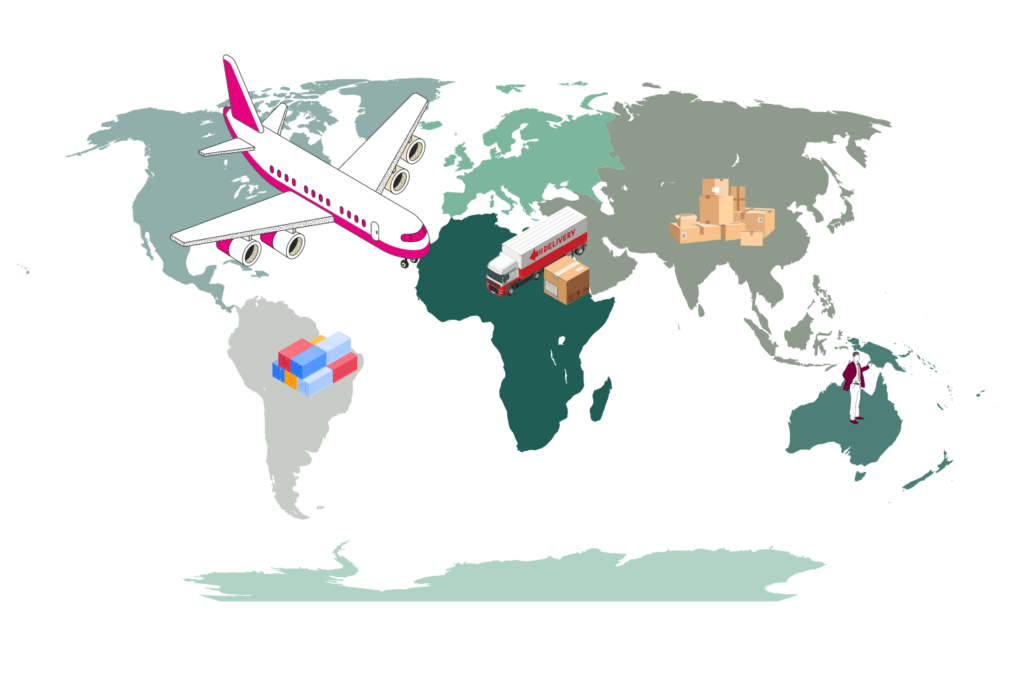Multimodal Transport
In logistics, the term multimodal transport, also referred to as multi-carrier shipping, describes the use of different means of transport (e.g. truck, train, vessel, airplane) and thus different modes of transport (road, rail, air, water) to process a closed transport process. The opposite of multimodality (interrupted transport) using multiple means of transport is direct transport (uninterrupted transport) using one means of transport.
Two or more modes of transport are involved in a multimodal transport, e.g. a transport by truck to the inland port, transport by vessel to the overseas port and then the crossing overseas. To simplify the loading of goods in multimodal transport, standardised transport units such as containers are often used to facilitate a seamless switch between modes of transports.
The following cases require a multimodal transport chain:
- Direct transport not possible without switching means of transport
- Goods need to be transshipped
- Bulk cargo or particularly heavy or long general cargo
- International transports via air or sea freight
Specialised forwarding companies with a great deal of professional knowledge are available to take over the detailed organisation and execution of a multimodal transport. Their job is to combine the modes of transport to ensure a resource-saving, efficient, and, at the same time, punctual, cost-efficient and smooth completion of the order.
Which terms are used synonymously?
It is important to differentiate and distinguish between multimodality and other terms such as intermodality or combined transport. In this context, we use the definition of the UN/ECE (Economic Commission for Europe) as a guideline, which drafted a document containing the most important technical terms.
MULTIMODAL TRAFFIC/TRANSPORT = the transport of goods with two or more modes of transport.
INTERMODAL TRAFFIC/TRANSPORT = a special form of multimodal transport. The transport of goods in the same loading unit (container, swap body, …) or the same road vehicle with two or more modes of transport. In this case, the individual goods never change, but solely the transport unit as a whole between the means of transport. The transported goods themselves are not transshipped. The goods are continually transported as a unit and never leave the loading unit (e.g. container).
COMBINED TRAFFIC/TRANSPORT = category of intermodal transport where the majority of the transport route is covered by train, airplane or vessel and the pre- and on-carriage by road are kept as short as possible.
Advantages and disadvantages of multimodal transport
The greatest advantage of multimodal transport is an effective and economical transport of goods through the combination of the respective advantages of the modes of transport. By combining the flexibility of a truck with the low energy consumption of a vessel or the speed of an airplane, the freight and storage costs can be reduced in addition to the duration of the transport.
Of course, multimodal transport is not the solution for all transport orders. Due to the combination of the modes of transport, it is essential that the time planning be thought through well and the appropriate service provider(s) be selected, which can be seen as the greatest disadvantage. If the modes of transport are not combined ideally, the weaknesses of the individual modes of transport may come to the fore. These are, for example, the low transport volume and, if applicable, high external costs in road transport. For rail transports and sea transports, the network is less dense than for road transports.
For multimodal transport, sufficient transport volume as well as goods suited for transport in loading units need to be available. Furthermore, the corresponding infrastructure needs to be available in the countries, as well as access to the different means of traffic and modes of transport. Terminals and hubs play a decisive role in the transshipment of the goods.
Another difficulty in multimodal transports is the transparency of the processes. Here, a transport management system can help display the complex processes and documents of a multimodal transport order in a detailed and structured way. With this digitalisation and the use of telematics, the control of complex transport chains is made much easier.
The add-on CarLo inAIR&SEA by Soloplan is an all-in-one solution for the transparent and comfortable processing of multimodal modes of transport. The entire transport process, including the pre-, main and on-carriage, is integrated in one system. CarLo inAIR&SEA can also integrate all necessary freight documents, such as the bill of lading, sea waybill, air waybill, etc.

See also:
Direct Transport The term direct transport (direct delivery/uninterrupted transport) refers to the transport of goods between two points without [...] Intermodal Transport Intermodal transport (intermodality) refers to the transport of goods across two or more modes of transport in a loading unit</ [...] Means of Transport Means of transport are all types of means of conveyance used to transport goods or people from one location to another [...] Combined Transport Combined transport is a type of intermodal (interrupted) transport. In combined transports, the advantages of different means of traffi [...]